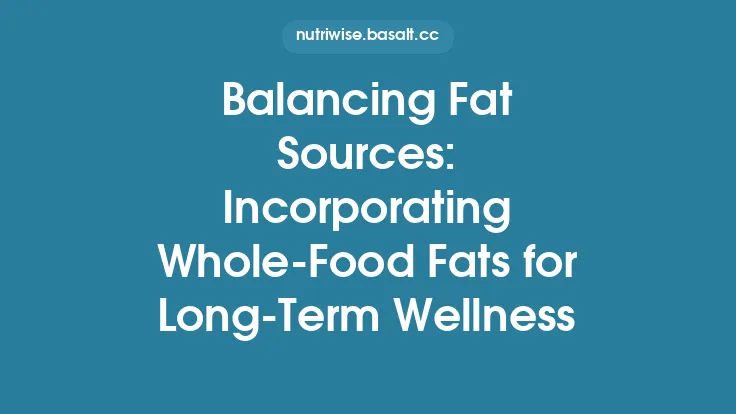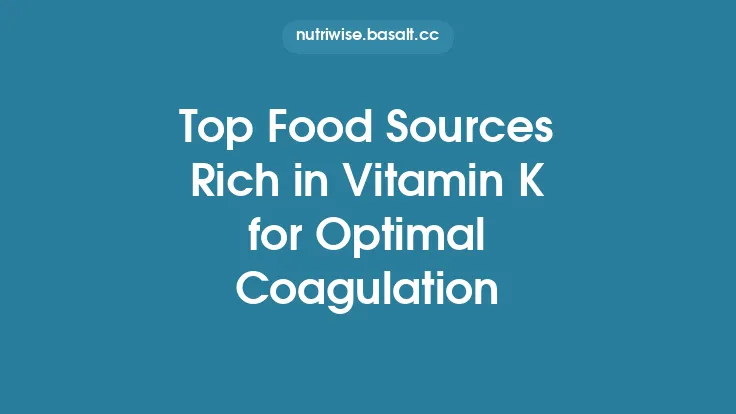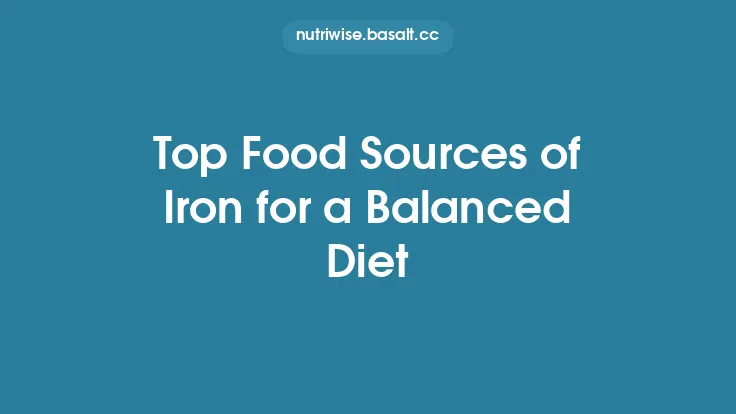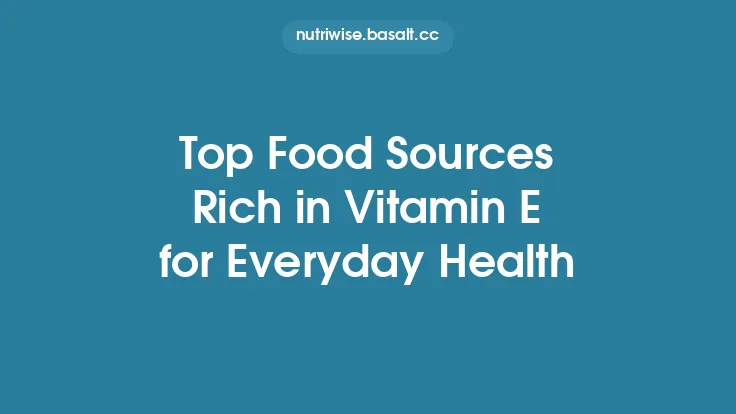Whole‑food sources are the foundation of a nutrient‑dense diet because they deliver vitamins, minerals, and trace elements in the natural matrices that our bodies have evolved to recognize and absorb. Unlike fortified processed products, whole foods provide a synergistic blend of micronutrients, phytochemicals, and fiber that together support optimal health. Below is a comprehensive guide to the top whole‑food categories that consistently deliver a high micronutrient punch, along with details on the specific nutrients they excel at providing, factors that influence bioavailability, and practical ways to incorporate them into everyday meals.
Why Whole Foods Outperform Isolated Supplements
- Matrix Effect – Micronutrients in whole foods are bound to proteins, fibers, and phytochemicals that can enhance absorption (e.g., the vitamin C in citrus fruits improves non‑heme iron uptake from plant sources).
- Synergistic Phytochemicals – Flavonoids, carotenoids, and polyphenols often act as antioxidants that protect vitamins and minerals from oxidative degradation during digestion.
- Reduced Antinutrient Load – While some whole foods contain compounds like phytic acid or oxalates that can hinder mineral absorption, traditional preparation methods (soaking, fermenting, sprouting, cooking) dramatically lower these inhibitors.
- Nutrient Stability – Whole foods retain a broader spectrum of micronutrients than fortified items, which may lose potency over time or during processing.
Understanding these principles helps you prioritize foods that naturally deliver the most “bang for the buck” in terms of micronutrient density.
Leafy Greens: A Micronutrient Powerhouse
| Food | Key Micronutrients (per 100 g) | Notable Phytochemicals |
|---|
| Kale | Vitamin K (817 µg, 1020 % DV), Vitamin C (120 mg, 133 % DV), Vitamin A (681 µg RAE, 76 % DV), Calcium (150 mg, 15 % DV), Manganese (0.6 mg, 30 % DV) | Kaempferol, Quercetin |
| Spinach | Folate (194 µg, 49 % DV), Iron (2.7 mg, 15 % DV), Magnesium (79 mg, 20 % DV), Vitamin K (483 µg, 603 % DV) | Lutein, Zeaxanthin |
| Swiss Chard | Vitamin K (830 µg, 1038 % DV), Vitamin A (306 µg RAE, 34 % DV), Potassium (379 mg, 8 % DV), Magnesium (81 mg, 20 % DV) | Betalains (antioxidant pigments) |
Bioavailability Tips
- Gentle Cooking (steaming 3–5 min) reduces oxalic acid, which otherwise binds calcium and iron, while preserving most water‑soluble vitamins.
- Pair with Healthy Fats (e.g., olive oil, avocado) to improve absorption of fat‑soluble vitamins A, D, E, and K.
Cruciferous Vegetables: Micronutrients and Protective Compounds
| Food | Key Micronutrients (per 100 g) | Unique Compounds |
|---|
| Broccoli | Vitamin C (89 mg, 99 % DV), Folate (63 µg, 16 % DV), Vitamin K (101 µg, 126 % DV), Potassium (316 mg, 7 % DV) | Sulforaphane (induces phase‑II detox enzymes) |
| Brussels Sprouts | Vitamin K (177 µg, 221 % DV), Vitamin C (85 mg, 94 % DV), Manganese (0.4 mg, 20 % DV) | Indole‑3‑carbinol (supports estrogen metabolism) |
| Cauliflower | Vitamin C (48 mg, 53 % DV), Folate (57 µg, 14 % DV), Choline (44 mg, 8 % DV) | Glucosinolates (precursors to isothiocyanates) |
Cooking Considerations
- Steam or stir‑fry rather than boiling to retain water‑soluble vitamins.
- Avoid over‑cooking to preserve glucosinolate content, which degrades at high temperatures.
Root Vegetables and Tubers: Mineral‑Rich Energy Sources
| Food | Key Micronutrients (per 100 g) | Additional Benefits |
|---|
| Sweet Potato | Vitamin A (709 µg RAE, 79 % DV), Vitamin C (19 mg, 21 % DV), Potassium (337 mg, 7 % DV), Manganese (0.3 mg, 15 % DV) | High in β‑carotene (pro‑vitamin A) |
| Beetroot | Folate (109 µg, 27 % DV), Manganese (0.3 mg, 15 % DV), Potassium (305 mg, 7 % DV) | Nitrates → nitric oxide (vascular health) |
| Carrots | Vitamin A (835 µg RAE, 93 % DV), Vitamin K (13 µg, 16 % DV), Biotin (6 µg, 2 % DV) | Lutein & zeaxanthin (eye health) |
Preparation Pointers
- Roasting at 180‑200 °C for 20‑30 min concentrates flavor and retains most micronutrients.
- Leaving skins on (where edible) adds fiber and additional minerals such as potassium and iron.
Legumes and Pulses: Plant‑Based Iron, Zinc, and Folate
| Food | Key Micronutrients (per 100 g, cooked) | Antinutrient Management |
|---|
| Lentils | Folate (181 µg, 45 % DV), Iron (3.3 mg, 18 % DV), Magnesium (36 mg, 9 % DV), Zinc (1.3 mg, 12 % DV) | Soak 4‑6 h, discard soaking water |
| Chickpeas | Folate (172 µg, 43 % DV), Iron (2.9 mg, 16 % DV), Copper (0.4 mg, 20 % DV) | Cook with a pinch of baking soda to reduce phytic acid |
| Black Beans | Folate (149 µg, 37 % DV), Magnesium (70 mg, 17 % DV), Potassium (355 mg, 8 % DV) | Sprouting for 1‑2 days boosts B‑vitamin content |
Enhancing Absorption
- Combine with Vitamin C‑rich foods (e.g., tomatoes, bell peppers) to improve non‑heme iron uptake.
- Ferment or sprout to lower phytic acid, thereby increasing zinc and iron bioavailability.
Nuts and Seeds: Concentrated Micronutrients and Healthy Fats
| Food | Key Micronutrients (per 30 g) | Notable Fatty Acids |
|---|
| Almonds | Vitamin E (7.3 mg, 49 % DV), Magnesium (76 mg, 19 % DV), Calcium (76 mg, 8 % DV) | Monounsaturated (oleic) |
| Brazil Nuts | Selenium (191 µg, 347 % DV), Magnesium (107 mg, 27 % DV) | Polyunsaturated (linoleic) |
| Pumpkin Seeds | Zinc (2.2 mg, 20 % DV), Iron (2.7 mg, 15 % DV), Copper (0.4 mg, 20 % DV) | Omega‑6 (linoleic) |
| Chia Seeds | Calcium (177 mg, 18 % DV), Magnesium (95 mg, 24 % DV), Phosphorus (265 mg, 27 % DV) | Alpha‑linolenic acid (ALA) |
Serving Strategies
- Soak nuts/seeds (4‑8 h) to reduce tannins and improve mineral absorption.
- Consume with a source of vitamin C (e.g., citrus dressing) when using them in salads to aid iron uptake.
Seafood and Shellfish: Oceanic Sources of Trace Minerals
| Food | Key Micronutrients (per 100 g) | Unique Elements |
|---|
| Oysters | Zinc (78 mg, 711 % DV), Selenium (77 µg, 140 % DV), Vitamin B12 (16 µg, 667 % DV) | High‑quality protein, omega‑3s |
| Mackerel | Vitamin D (16 µg, 106 % DV), Selenium (55 µg, 100 % DV), Vitamin B6 (0.9 mg, 53 % DV) | EPA/DHA omega‑3 fatty acids |
| Sardines (canned in water) | Calcium (382 mg, 38 % DV), Vitamin B12 (8.9 µg, 371 % DV), Phosphorus (490 mg, 70 % DV) | Whole small fish retain bones |
| Seaweed (nori) | Iodine (16 µg, 11 % DV), Iron (2.2 mg, 12 % DV), Vitamin C (15 mg, 17 % DV) | Rich in polysaccharides (fucoidan) |
Preparation Notes
- Limit high‑sodium preparations (e.g., heavily salted fish) to avoid excess sodium intake.
- Cook shellfish briefly (steaming, quick sauté) to preserve heat‑sensitive B‑vitamins while ensuring safety.
Organ Meats and Offal: Concentrated Micronutrient Reservoirs
| Food | Key Micronutrients (per 100 g) | Highlights |
|---|
| Beef Liver | Vitamin A (16 000 µg RAE, 1778 % DV), Vitamin B12 (70 µg, 2917 % DV), Folate (290 µg, 73 % DV), Iron (6.2 mg, 34 % DV) | Highest natural source of preformed vitamin A |
| Chicken Gizzard | Zinc (2.5 mg, 23 % DV), Selenium (30 µg, 55 % DV), Vitamin B6 (0.5 mg, 29 % DV) | Rich in collagen‑building amino acids |
| Kidney (beef) | Riboflavin (2.2 mg, 129 % DV), Vitamin B12 (30 µg, 1250 % DV), Copper (1.2 mg, 133 % DV) | Excellent for energy‑production enzymes |
Safety & Frequency
- Consume in moderation (once or twice a month) due to high vitamin A and cholesterol content.
- Source from reputable producers to minimize exposure to contaminants (e.g., heavy metals).
Fermented Foods and Probiotic Sources: Micronutrients Plus Microbial Benefits
| Food | Key Micronutrients (per 100 g) | Probiotic Strains |
|---|
| Sauerkraut | Vitamin C (14 mg, 16 % DV), Vitamin K (15 µg, 19 % DV), Iron (1.2 mg, 7 % DV) | *Leuconostoc, Lactobacillus* spp. |
| Kimchi | Vitamin A (30 µg RAE, 3 % DV), Vitamin C (21 mg, 23 % DV), Calcium (33 mg, 3 % DV) | *Lactobacillus kimchii, Leuconostoc mesenteroides* |
| Miso | Vitamin K (30 µg, 38 % DV), Manganese (0.5 mg, 25 % DV), Copper (0.2 mg, 22 % DV) | *Aspergillus oryzae* (koji) |
| Greek Yogurt (plain, 2% fat) | Calcium (110 mg, 11 % DV), Vitamin B12 (0.5 µg, 21 % DV), Riboflavin (0.2 mg, 12 % DV) | *Lactobacillus bulgaricus, Streptococcus thermophilus* |
Micronutrient Enhancement
- Fermentation can increase bioavailability of B‑vitamins (e.g., riboflavin, folate) and reduce antinutrients such as phytic acid in plant substrates.
- Pair fermented vegetables with a small amount of healthy fat (e.g., drizzle of olive oil) to aid absorption of fat‑soluble vitamins present in the raw ingredients.
Practical Tips for Maximizing Micronutrient Absorption
| Strategy | How It Works | Example Application |
|---|
| Eat a Rainbow | Different pigments (chlorophyll, carotenoids, anthocyanins) signal distinct phytonutrients and associated minerals. | Include at least three colors per meal: red bell pepper, orange carrot, green kale. |
| Mind the Cooking Method | Heat can destroy heat‑sensitive vitamins (C, folate) but also break down cell walls, releasing bound minerals. | Lightly steam broccoli (5 min) vs. boiling (10 min) to preserve vitamin C while softening tissue. |
| Combine Fat‑Soluble Vitamins with Lipids | Vitamins A, D, E, K dissolve in dietary fat, which facilitates micelle formation and intestinal uptake. | Toss roasted sweet potatoes with 1 tsp of avocado oil. |
| Use Acidic Medium for Iron | Vitamin C reduces ferric (Fe³⁺) to ferrous (Fe²⁺) form, which is more readily absorbed. | Add a squeeze of lemon juice to a lentil salad. |
| Soak, Sprout, Ferment | These processes activate endogenous enzymes that degrade phytic acid and other inhibitors. | Soak chickpeas overnight, then cook; or ferment cabbage into sauerkraut. |
| Avoid Excessive Antioxidant Supplements with Meals | High doses of isolated antioxidants (e.g., vitamin C tablets) can compete with food‑derived nutrients for absorption pathways. | Prefer whole‑food sources over large supplemental doses when possible. |
| Space Out Calcium‑Rich Foods and Iron‑Rich Foods | Calcium can interfere with non‑heme iron absorption when consumed together in large amounts. | Have a calcium‑rich snack (yogurt) separate from an iron‑rich main (spinach salad). |
Bottom Line
By focusing on whole‑food categories that naturally concentrate a broad spectrum of vitamins, minerals, and supportive phytochemicals, you can build a diet that consistently meets—or exceeds—daily micronutrient requirements without relying on fortified products or supplements. The foods highlighted above are not only nutrient dense but also versatile, allowing you to create meals that are both delicious and nutritionally robust. Remember that preparation matters: gentle cooking, strategic food pairings, and traditional processing methods (soaking, sprouting, fermenting) unlock the full micronutrient potential of these powerhouse foods. Incorporate a variety of them daily, and you’ll enjoy sustained energy, stronger immunity, and long‑term health benefits rooted in the very foods that nature intended.





